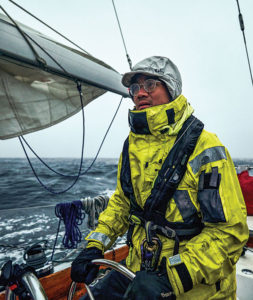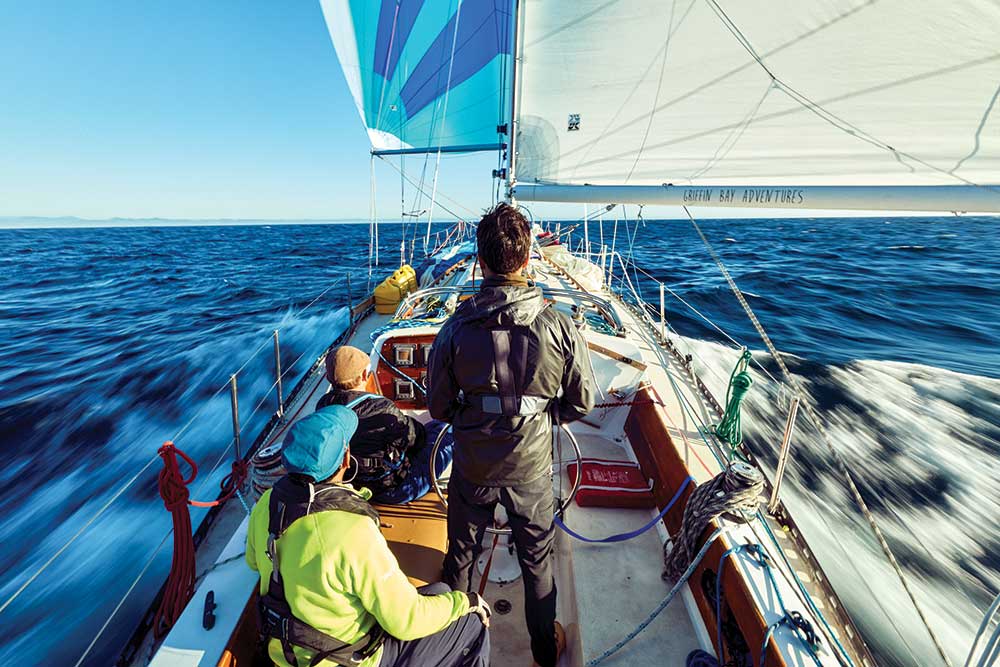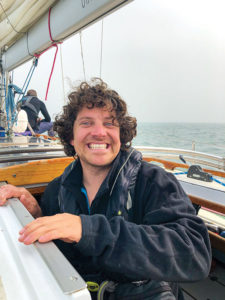In our latest Throwback Thursday, we find out what it’s like parting with a beloved boat after three years and more than 3,000 miles.
Some say that the happiest days of a boat owner’s life are the day they buy a boat and the day they sell it. I can tell you that, although that may be true for some, it is not true for me.
I’ve been thinking about what it means to be a boat owner recently. After three years and well over 3,000 miles, the time had come to say goodbye to Journeyman — the Cal 40 I have been using as a teaching platform for Griffin Bay Adventures, my sailing school in the San Juan Islands.
Journeyman’s commercial insurance had come up for renewal and, after much searching, no coverage could be found for the 50-year-old boat, despite her great pedigree. As would be the case with any craft one has shared so many miles with, she was close to my heart. But she was also a business asset, and — no longer able to work for her moorage — now an albatross around my neck in these hard times for the sail training industry.
As I prepared to sell the boat, I itemized the upgrades we had done on the listing and, going through the pictures, I was flooded with all the fond memories of adventure made aboard. I remember well the 21 days it took to sail her back from Hawaii; how impressed I was that all I’d read about the boat’s good ocean sailing character was true. I remembered the Oregon Offshore Race in which we took away a second place trophy; and how proud I was not only that we had done well, but we’d done it with students as a sail training class. I remembered the race around San Juan County with friends when we did not place so well, but brought the cast iron cookware and enjoyed the finest underway fare of any race I’ve ever participated in. I remembered the three-day trip to Vancouver, British Columbia last year for New Years with good friends. I remember cruising around the Gulf Islands with a girlfriend — blissed-out, bellies full of oysters, snugged down in a favorite newly discovered anchorage.
At best, we are stewards of our boats for a time; and we’re not the only ones to derive joy from these vessels. If we take care of our craft like we hope they will take care of us, we should try to pass them on in better shape than when we got them so they can be enjoyed for generations.
I remember looking at Journeyman briefly in Hawaii while I was getting a Santa Cruz 50 ready to deliver back to San Francisco. The Cal 40 had a recent refit, but was in rough shape after being handled poorly on her way to Hawaii by her former owners. Both her stem fitting and gooseneck were broken, and her jib and furler were damaged so badly that they had been thrown in the dumpster after the crossing. She was in rough shape, but I saw her potential as a solid sail-training platform and those sweet classic lines didn’t hurt. A little work and she would be ready for the 2,500-plus mile trip home.
The misadventures endear you to your craft as well as the smooth sailing and sexy lines. After I bought her and set sail for the Pacific Northwest from Hawaii, I can vividly recall the shaky-handed jury rigging job we did that kept the rudder from can-opening a hole in the hull when the top rudder bearing sheared off its bolts 1,000 miles from land. Our jury rig held for the rest of the trip. After we arrived I glassed in big gussets fore and aft and athwartships to take any load off the new top bearing hardware.
Maybe it’s all the work that you put in — and the confidence that comes from it — that makes it so hard to say goodbye. In those first months, I remember my folks helping with the varnish, painting, rail re-bedding and V-drive rebuild. All the hours working on the boat with them are happy memories. Despite the pain of letting go, I knew that I was passing along a boat that was better for our time together.
From bluewater passages to day sailing, she never let me down. Perhaps these are the reasons so many marinas are choked with sorry derelicts or vessels not far off. The memories of the good times make people hang on to their boats beyond their ability to steward them. Then guilt sets in after the boat has been let go so far that it keeps them away from the marina, moorage payments on auto-draft. Letting go is difficult.
After the listing went up, it was not long before a young and aspiring sailor from California purchased the boat and it was time to say goodbye to Journeyman. Fortunately, though, he would need the boat delivered and I would get one last adventure to soothe this bittersweet passing of the torch.
Friday Harbor to San Francisco — A last adventure with friends

The first to sign on to the crew were Eric Cheong and Martin Gibson. I have shared more than 5,000 miles with these guys on different deliveries and races and I can’t think of better examples of how character is first and foremost at sea. Eric and Martin are the paragon of seagoing gentlemen and, in addition to being invaluable on deck, are always glad to help organize, cook, do dishes, or clean. Martin was my first mate, crew, navigator, fiberglass repair specialist, and guidance counselor for our doublehanded Pac Cup on my Moore 24, Evermoore. Eric joined a delivery back from Hawaii the following year and has been a real rockstar guest on many more recreational boating activities. With a strong crew like these two aboard, we didn’t really need anyone else; but it was too fun a passage to not want to share it with more people.
Next on the crew were Har Rai Khalsa and Madison “Mad Dog” Rowley. Har Rai had joined on a short delivery from Port Angeles to Portland years ago and I remember him asking to climb the mast as we sailed up the river to Portland, kite up and all, to get a picture. A backcountry athlete and professional outdoor sports photographer, here is a guy who would climb a mast or dive under the boat at the drop of a hat if necessary — and with a grin on his face.
Mad Dog is a strange nickname for such a refined gent. We first sailed together as teenagers when I was teaching for junior sailing camps in Portland. Our friendship is more proof, if anyone ever needed it, that fellowship forged on the water endures.

The last to join this well acquainted and handsome bunch was Kyle Hadley, who I met on social media when he was asked for advice about his new-to-him Cascade 29. A tough, self-taught sailor, who happened to be the youngest person on our crew, Kyle is not someone that would sign up for a typical sailing lesson, but he is a perfect candidate for what I’ve come to call a seagoing apprenticeship. Kyle’s genuine passion and curiosity about everything sailing confirms that he will be one of the few to really go and do the bluewater sailing thing so many dream about but never do.
What a Cal 40 Does Best
The direction and time of year of this delivery promised to offer some of the best sailing you can do with a Cal 40. These boats just love a bunch of wind abaft the beam. And when you add a following sea, the helm just lightens up and you can’t stop grinning.
From Journeyman’s ship’s log on the delivery, 9-9-20: The sun is setting now, we have the 3/4 asymmetrical kite on the pole, and when surfing we are hitting 11 knots. A three-course Indian dinner is being prepared by Har Rai and the tantalizing aromas waft through the boat and into the cockpit. Thundering along in 20 knots of wind about 10 miles offshore, the forecast looks good. High-fives and good vibes abound.
The most riveting sea stories are made of stuff going wrong, but I don’t think any sailor will deny that those perfect moments between human and boat and wind and sea are what we really live for. Having these kinds of experiences sailing and sharing them with some of your best shipmates makes up for any mid ocean head rebuild or any of the other unfun work that boat ownership involves.
It’s Not All Beer and Skittles
Ship’s log 9-13-20: So far, we have been lucky rounding the capes as we sail south, but as we approach the infamous Cape Mendocino, it seems that we will get some uncomfortable conditions. At sunset, the wind is gusting 20+ from the south and a confused sea is running from the conflicting winds that have been blowing the past few days in the area. I’m in the port quarter berth when we come off a wave on port tack and the range comes free from its gimbals. Fortunately, the solenoid is off and the LPG hose isn’t damaged. We get it back on the gimbals and secured so dinner can be made.
Ships log 9-15-20: We are heading dead downwind and have the #2 jib poled out and the main preventer on. It’s gusting 25+ and the sea state is still confused so the helm is a handful. At 10 p.m., the helmsman backwinds the main, the preventer stops the jibe but the boom vang breaks. A few hours later on the next watch, the #2 is back-winded one too many times and blows up. No worries, it was an old sail. The #3 goes up and fresh hands get on the helm.
The boom and its affiliated parts are common points of failure. The vang breaking reminds me of past issues with these important moving parts. The previous evening’s vang failure was just the fitting popping its two rivets and bending its way out. The next day, Marty got to jury rigging and managed to reshape it and slip it back in the track with a lashing to the unused loop just aft of the vang attach point. This fix was eerily similar to one Martin had done when we were racing to Hawaii on Evermoore. There was a lesson here: it is important to have fuses in the rigging and strong isn’t always the best. One would always rather have the vang break than the boom or mast or gooseneck. Things break, you jury rig, and then when back ashore you improve the design.
I may be someone who drank more of the Koolaid than most, but I can’t think of any thing that can bring people together as a team — while pushing everyone’s limits and horizons — like a boat and some sea miles.
While the forest fires raged on shore and who knows what was going on in the political world at large, our little tribe had come together. Watches were running smoothly and everyone was in sync. I secretly just wished we had further to go.

Passing it On
Ship’s log 9-18-20: The wind has tapered and we are motoring into the pitch black night. The smoke from the forest fires has blacked out any stars or moonlight. The light of phosphorescence in our wake is very bright. Adding to the surreal moment, three Sooty Petrels have joined us for a ride in the cockpit. These small coal-black birds don’t seem to be afraid of the crew, and even let us pick them up as we relocate them to less dangerous places. Perhaps it’s the light from our navigation instruments in the cockpit that has drawn them to us.
The fog lifted the next day and the Golden Gate Bridge came into view. Everyone was on deck, seabirds and whales all around seemed to greet us as we passed under this iconic bridge. Our journey was coming to an end and like all endings, it was a little sad.

Life sometimes finds us far and years apart from our best friends. Work, “adulting”, and raising families come between us and those that were so important in our younger years. Thinking about this really shows me how important it is to have adventures like this with your friends. The time and money spent to make those memories are quickly forgotten. As we head under the gate back to civilization, the sweetness of the presence of mind that you must live underway offshore is replaced with the plans and concerns the shore requires. My band of seaward brothers was breaking up and heading back to reality. The feelings of sadness about letting go of the boat are now small compared to the feelings of how important the time with good people is.
As this chapter closes with Journeyman back in California where she was made, and me closing on a new boat to teach on, I can’t help but see the moral of this story.
The memories and miles are gold. The boat…well, that’s just stuff.
Unless otherwise noted, all photos in this article were taken by crew member and professional photographer, Har Rai Khalsa.
Note: This article was originally published in the January 2021 issue of 48° North.






